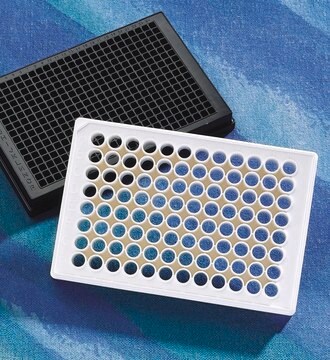A-003-M
Poly-ᴅ-Lysine Hydrobromide
synthetic, liquid, 1 mg/mL, suitable for cell culture
Synonim(y):
poly lysine
About This Item
Polecane produkty
product name
Poly-D-Lysine solution, 1.0 mg/mL, The Poly-D-Lysine solution promotes the adhesion of tissues/sections to the culture vessel.
Poziom jakości
Postać
liquid
producent / nazwa handlowa
Specialty Media
metody
cell culture | mammalian: suitable
moc wejściowa
sample type neural stem cell(s)
sample type epithelial cells
sample type: human embryonic stem cell(s)
sample type hematopoietic stem cell(s)
sample type mesenchymal stem cell(s)
sample type pancreatic stem cell(s)
sample type induced pluripotent stem cell(s)
Opis ogólny
Zastosowanie
- To coat culture vessels and provide a suitable surface for the growth and attachment of neuronal cells.
- In preparing the surface of coverslips for facilitating the attachment of non-adherent cells.
Działania biochem./fizjol.
Cechy i korzyści
- Poly-D-Lysine (PDL) solution is diluted in phosphate buffer saline (PBS), water, or 0.1M borate buffer.
- Working dilutions of 50μg/mL to 100μg/mL are usually adequate.
- It has a surface coverage of 3-10μg/cm2.
- PDL can be stored at -20 ˚C for up to 18 months.
- Plates are coated for 3 hours overnight and up to 3 days when stored at 4˚C.
- PDL-coated plates are used immediately or stored in PBS for up to 5 days.
Postać fizyczna
Uwaga dotycząca przygotowania
Przechowywanie i stabilność
Kod klasy składowania
12 - Non Combustible Liquids
Klasa zagrożenia wodnego (WGK)
nwg
Temperatura zapłonu (°F)
Not applicable
Temperatura zapłonu (°C)
Not applicable
Certyfikaty analizy (CoA)
Poszukaj Certyfikaty analizy (CoA), wpisując numer partii/serii produktów. Numery serii i partii można znaleźć na etykiecie produktu po słowach „seria” lub „partia”.
Masz już ten produkt?
Dokumenty związane z niedawno zakupionymi produktami zostały zamieszczone w Bibliotece dokumentów.
Klienci oglądali również te produkty
Produkty
Extracellular matrix proteins such as laminin, collagen, and fibronectin can be used as cell attachment substrates in cell culture.
Nasz zespół naukowców ma doświadczenie we wszystkich obszarach badań, w tym w naukach przyrodniczych, materiałoznawstwie, syntezie chemicznej, chromatografii, analityce i wielu innych dziedzinach.
Skontaktuj się z zespołem ds. pomocy technicznej








